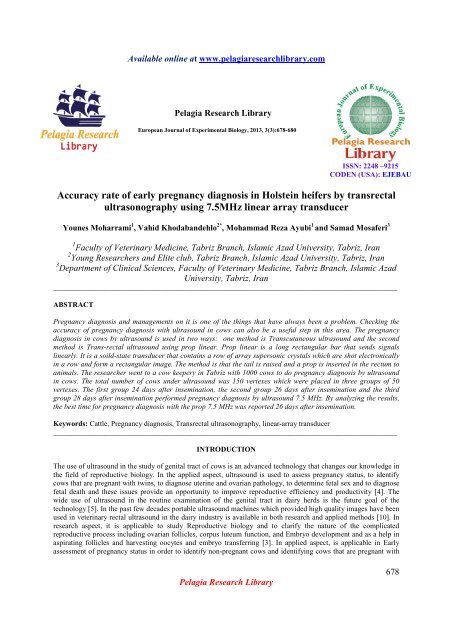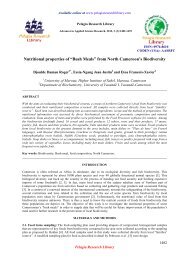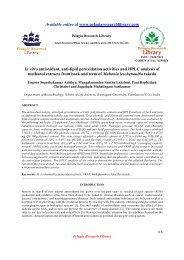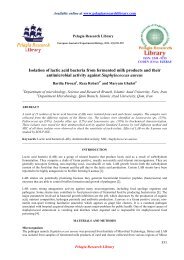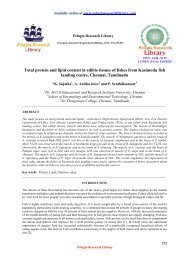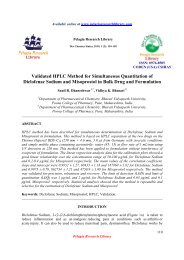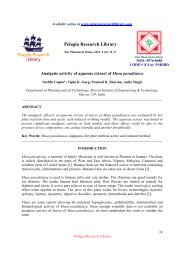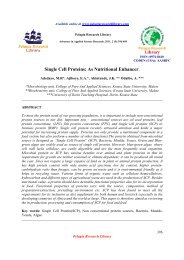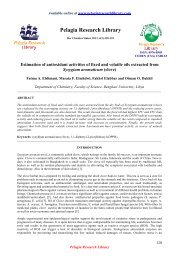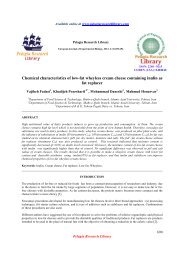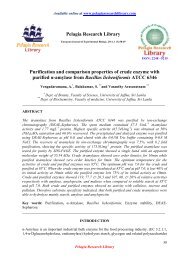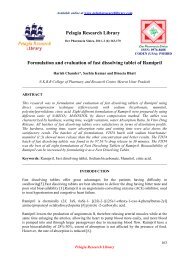Accuracy rate of early pregnancy diagnosis in Holstein heifers by ...
Accuracy rate of early pregnancy diagnosis in Holstein heifers by ...
Accuracy rate of early pregnancy diagnosis in Holstein heifers by ...
Create successful ePaper yourself
Turn your PDF publications into a flip-book with our unique Google optimized e-Paper software.
Available onl<strong>in</strong>e at www.pelagiaresearchlibrary.com<br />
Pelagia Research Library<br />
European Journal <strong>of</strong> Experimental Biology, 2013, 3(3):678-680<br />
ISSN: 2248 –9215<br />
CODEN (USA): EJEBAU<br />
<strong>Accuracy</strong> <strong>rate</strong> <strong>of</strong> <strong>early</strong> <strong>pregnancy</strong> <strong>diagnosis</strong> <strong>in</strong> Holste<strong>in</strong> <strong>heifers</strong> <strong>by</strong> transrectal<br />
ultrasonography us<strong>in</strong>g 7.5MHz l<strong>in</strong>ear array transducer<br />
Younes Moharrami 1 , Vahid Khodabandehlo 2* , Mohammad Reza Ayubi 1 and Samad Mosaferi 3<br />
1 Faculty <strong>of</strong> Veter<strong>in</strong>ary Medic<strong>in</strong>e, Tabriz Branch, Islamic Azad University, Tabriz, Iran<br />
2 Young Researchers and Elite club, Tabriz Branch, Islamic Azad University, Tabriz, Iran<br />
3 Department <strong>of</strong> Cl<strong>in</strong>ical Sciences, Faculty <strong>of</strong> Veter<strong>in</strong>ary Medic<strong>in</strong>e, Tabriz Branch, Islamic Azad<br />
University, Tabriz, Iran<br />
_____________________________________________________________________________________________<br />
ABSTRACT<br />
Pregnancy <strong>diagnosis</strong> and managements on it is one <strong>of</strong> the th<strong>in</strong>gs that have always been a problem. Check<strong>in</strong>g the<br />
accuracy <strong>of</strong> <strong>pregnancy</strong> <strong>diagnosis</strong> with ultrasound <strong>in</strong> cows can also be a useful step <strong>in</strong> this area. The <strong>pregnancy</strong><br />
<strong>diagnosis</strong> <strong>in</strong> cows <strong>by</strong> ultrasound is used <strong>in</strong> two ways: one method is Transcutaneous ultrasound and the second<br />
method is Trans-rectal ultrasound us<strong>in</strong>g prop l<strong>in</strong>ear. Prop l<strong>in</strong>ear is a long rectangular bar that sends signals<br />
l<strong>in</strong><strong>early</strong>. It is a soild-state transducer that conta<strong>in</strong>s a row <strong>of</strong> array supersonic crystals which are shot electronically<br />
<strong>in</strong> a row and form a rectangular image. The method is that the tail is raised and a prop is <strong>in</strong>serted <strong>in</strong> the rectum to<br />
animals. The researcher went to a cow keepery <strong>in</strong> Tabriz with 1000 cows to do <strong>pregnancy</strong> <strong>diagnosis</strong> <strong>by</strong> ultrasound<br />
<strong>in</strong> cows. The total number <strong>of</strong> cows under ultrasound was 150 vertexes which were placed <strong>in</strong> three groups <strong>of</strong> 50<br />
vertexes. The first group 24 days after <strong>in</strong>sem<strong>in</strong>ation, the second group 26 days after <strong>in</strong>sem<strong>in</strong>ation and the third<br />
group 28 days after <strong>in</strong>sem<strong>in</strong>ation performed <strong>pregnancy</strong> <strong>diagnosis</strong> <strong>by</strong> ultrasound 7.5 MHz. By analyz<strong>in</strong>g the results,<br />
the best time for <strong>pregnancy</strong> <strong>diagnosis</strong> with the prop 7.5 MHz was reported 26 days after <strong>in</strong>sem<strong>in</strong>ation.<br />
Keywords: Cattle, Pregnancy <strong>diagnosis</strong>, Transrectal ultrasonography, l<strong>in</strong>ear-array transducer<br />
_____________________________________________________________________________________________<br />
INTRODUCTION<br />
The use <strong>of</strong> ultrasound <strong>in</strong> the study <strong>of</strong> genital tract <strong>of</strong> cows is an advanced technology that changes our knowledge <strong>in</strong><br />
the field <strong>of</strong> reproductive biology. In the applied aspect, ultrasound is used to assess <strong>pregnancy</strong> status, to identify<br />
cows that are pregnant with tw<strong>in</strong>s, to diagnose uter<strong>in</strong>e and ovarian pathology, to determ<strong>in</strong>e fetal sex and to diagnose<br />
fetal death and these issues provide an opportunity to improve reproductive efficiency and productivity [4]. The<br />
wide use <strong>of</strong> ultrasound <strong>in</strong> the rout<strong>in</strong>e exam<strong>in</strong>ation <strong>of</strong> the genital tract <strong>in</strong> dairy herds is the future goal <strong>of</strong> the<br />
technology [5]. In the past few decades portable ultrasound mach<strong>in</strong>es which provided high quality images have been<br />
used <strong>in</strong> veter<strong>in</strong>ary rectal ultrasound <strong>in</strong> the dairy <strong>in</strong>dustry is available <strong>in</strong> both research and applied methods [10]. In<br />
research aspect, it is applicable to study Reproductive biology and to clarify the nature <strong>of</strong> the complicated<br />
reproductive process <strong>in</strong>clud<strong>in</strong>g ovarian follicles, corpus luteum function, and Embryo development and as a help <strong>in</strong><br />
aspirat<strong>in</strong>g follicles and harvest<strong>in</strong>g oocytes and embryo transferr<strong>in</strong>g [3]. In applied aspect, is applicable <strong>in</strong> Early<br />
assessment <strong>of</strong> <strong>pregnancy</strong> status <strong>in</strong> order to identify non-pregnant cows and identify<strong>in</strong>g cows that are pregnant with<br />
Pelagia Research Library<br />
678
Vahid Khodabandehlo et al Euro. J. Exp. Bio., 2013, 3(3):678-680<br />
_____________________________________________________________________________<br />
tw<strong>in</strong>s <strong>in</strong> order to implement various management practices to reduce or elim<strong>in</strong>ate the negative effects <strong>of</strong> tw<strong>in</strong> birth<br />
[8], accu<strong>rate</strong> <strong>diagnosis</strong> <strong>of</strong> the pathology <strong>of</strong> the uterus and ovaries <strong>in</strong> order to treat them accu<strong>rate</strong>ly and to determ<strong>in</strong>e<br />
Fetal sex with economic objectives [7]. So ultrasound should not be seen as a secondary management tool, but it<br />
should be used <strong>in</strong> the rout<strong>in</strong>e exam<strong>in</strong>ations <strong>of</strong> veter<strong>in</strong>ary and <strong>in</strong> dairy herd [10]. So the use <strong>of</strong> rectal ultrasound for<br />
the assessment <strong>of</strong> reproductive structures <strong>in</strong> cows has improved diagnostic capabilities <strong>of</strong> veter<strong>in</strong>arians <strong>in</strong><br />
comparison to rectal palpation.<br />
MATERIALS AND METHODS<br />
This study was conducted <strong>in</strong> an <strong>in</strong>dustrial cow keepery with 1000 cows <strong>in</strong> East Azerbaijan on 150 <strong>heifers</strong> <strong>in</strong>oculated<br />
dur<strong>in</strong>g the n<strong>in</strong>e months from April to December 2011. Practices <strong>in</strong> the dairy milk<strong>in</strong>g were done 3 times daily, at 6 <strong>in</strong><br />
the morn<strong>in</strong>g and 14 and 22 at night. 150 <strong>in</strong>oculated <strong>heifers</strong> (<strong>in</strong>oculated at 12-10 h after estrus) were randomly<br />
divided <strong>in</strong>to 3 groups <strong>of</strong> 50 vertexes. Heifers <strong>of</strong> the first group were identified 24 days after <strong>in</strong>sem<strong>in</strong>ation, <strong>heifers</strong> <strong>of</strong><br />
the second group 24 days after <strong>in</strong>sem<strong>in</strong>ation and <strong>heifers</strong> <strong>of</strong> the third group 28 days after <strong>in</strong>sem<strong>in</strong>ation <strong>by</strong> trans-rectal<br />
ultrasound us<strong>in</strong>g prop l<strong>in</strong>ear 7.5MHZ. In such a way that Heifers were bounded <strong>in</strong> a relatively dark place, the<br />
midwifery gloves and prop were sta<strong>in</strong>ed to the gel. (To prevent damage to the rectal) then the animal's rectum was<br />
evacuated, then the animal’s tail is raised <strong>by</strong> veter<strong>in</strong>arian or <strong>by</strong> another person. The prop approximately 20-40 cm<br />
was <strong>in</strong>serted <strong>in</strong>to the rectum and bladder was observed. Upon see<strong>in</strong>g the bladder, prop was lead <strong>in</strong> a ventral manner.<br />
Then prop was rotated <strong>by</strong> an angle <strong>of</strong> 45 degrees <strong>in</strong> both directions to make the womb observable upon see<strong>in</strong>g the<br />
uter<strong>in</strong>e, both uter<strong>in</strong>e horns were checked and the presence <strong>of</strong> fetal fluids <strong>in</strong>side the horns and potential embryo <strong>in</strong><br />
liquids were the <strong>in</strong>dicators <strong>of</strong> <strong>pregnancy</strong>. After see<strong>in</strong>g the fetus the image was created. The ultrasound <strong>heifers</strong> were<br />
noted <strong>in</strong> terms <strong>of</strong> <strong>pregnancy</strong> and non- <strong>pregnancy</strong>. Heifers <strong>in</strong> three groups were exam<strong>in</strong>ed <strong>by</strong> ultrasound on day 45 <strong>of</strong><br />
<strong>pregnancy</strong> and f<strong>in</strong>ally the accuracy <strong>of</strong> <strong>pregnancy</strong> <strong>diagnosis</strong> was reported on days 24.26 and 28.<br />
RESULTS<br />
The results <strong>of</strong> this study are as follows: 31 <strong>heifers</strong> <strong>in</strong> the first group (24 days after <strong>in</strong>sem<strong>in</strong>ation) were pregnant and<br />
19 <strong>of</strong> them were nonpregnant and all The 31 cases were real positive, but only 3 cases from 19 nonpregnants were<br />
false negative. In fact 34 <strong>heifers</strong> were pregnant <strong>by</strong> ultrasound on day 45. There were 3 cases <strong>of</strong> false negatives on<br />
day 24. So sensitivity was 93.05% and specificity was 100%. Accord<strong>in</strong>g to these figures, the positive predictive<br />
value was 100% and negative predictive value was 84.86%. In the second group 34 <strong>heifers</strong> were pregnant and 16<br />
cases were non-pregnant and there were no false-negative or false-positive. Accord<strong>in</strong>g to the ultrasound conducted<br />
on day 45, sensitivity and specificity were obta<strong>in</strong>ed 100 %. With regard to these cases the positive predictive values<br />
was 100 % and negative predictive value was 100%. In the third group 34 <strong>heifers</strong> were pregnant and 16 cases were<br />
non-pregnant. This group has no false positives and no false negatives on day 28 which have been diagnosed with<br />
ultrasound 7.5MHZ. Sensitivity and specificity were 100 % <strong>in</strong> this group. And the positive predictive value <strong>of</strong> was<br />
100% and the negative predictive value was 100%.<br />
Table 1<br />
No. <strong>of</strong> exam<strong>in</strong>ation<br />
No. <strong>of</strong> pregnant at TRUS<br />
No. <strong>of</strong> non pregnant at TRUS<br />
No. <strong>of</strong> correctly classified pregnant<br />
No. <strong>of</strong> <strong>in</strong>correctly classified pregnant<br />
No. <strong>of</strong> correctly classified nonpregnant<br />
No. <strong>of</strong> <strong>in</strong>correctly classified nonpregnant<br />
No. <strong>of</strong> pregnant on days 45post AI (<strong>diagnosis</strong> <strong>by</strong> TRUS)<br />
No. <strong>of</strong> non-pregnant on days 45 post AI (<strong>diagnosis</strong> <strong>by</strong> TRUS)<br />
Sensitivity (%)<br />
Specificity (%)<br />
Positive predictive value (PPV ;%)<br />
Negative predictive value (NPV ;%)<br />
24<br />
50<br />
31<br />
19<br />
31<br />
0<br />
16<br />
3<br />
34<br />
16<br />
93.05<br />
100<br />
100<br />
86.84<br />
Days<br />
26<br />
50<br />
34<br />
16<br />
34<br />
0<br />
33<br />
0<br />
34<br />
16<br />
100<br />
100<br />
100<br />
100<br />
28<br />
50<br />
34<br />
16<br />
34<br />
0<br />
33<br />
0<br />
34<br />
16<br />
100<br />
100<br />
100<br />
100<br />
Pelagia Research Library<br />
679
Vahid Khodabandehlo et al Euro. J. Exp. Bio., 2013, 3(3):678-680<br />
_____________________________________________________________________________<br />
DISCUSSION<br />
There are many articles about the accuracy <strong>of</strong> <strong>pregnancy</strong> <strong>diagnosis</strong> us<strong>in</strong>g ultrasound <strong>in</strong> <strong>heifers</strong> [1]. However, very<br />
few studies, exam<strong>in</strong>ed the sensitivity, specificity, positive predictive value and negative predictive value based on<br />
each day <strong>by</strong> trans-rectal ultrasound [4, 5, 10, 11]. Some researchers have reported that <strong>by</strong> us<strong>in</strong>g trans-rectal<br />
ultrasound the pregnant <strong>heifers</strong> can be detected 9 days after <strong>in</strong>sem<strong>in</strong>ation [9]. But such research can be done only <strong>in</strong><br />
special circumstances and requires a lot <strong>of</strong> time Also it has a very low accuracy and is not possible <strong>in</strong> practical terms<br />
[9]. Some researches advise us<strong>in</strong>g trans-rectal ultrasound on days 25 or 26 [6]. But this study is contrary to other<br />
reports because <strong>of</strong> high <strong>rate</strong>s <strong>of</strong> false-negative <strong>diagnosis</strong> at this time. In a study conducted <strong>by</strong> a group <strong>of</strong> researchers<br />
at Texas A & M University (abc) 1079 cows and 321 <strong>heifers</strong> were exam<strong>in</strong>ed <strong>by</strong> ultrasound us<strong>in</strong>g prop l<strong>in</strong>ear 5MHZ<br />
[5]. Cows were randomly exam<strong>in</strong>ed once between days 24 and 30, <strong>heifers</strong> between days 21 and 27 <strong>by</strong> ultrasound<br />
and for the second time <strong>in</strong> three days after that, namely day 31 to 38 for cows (estrus = Day 0) and <strong>heifers</strong><br />
approximately days 24 through 31. The sensitivity and specificity <strong>of</strong> cows and <strong>heifers</strong> were compared from days 24<br />
and 27. The sensitivity gradually <strong>in</strong>creased from 74.5% to 100% <strong>in</strong> 29 days.(p


